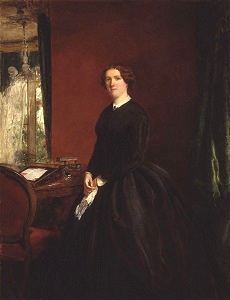De Engelse schrijfster Mary Elizabeth Braddon werd geboren in Londen op 4 oktober 1837. Haar vader, Henry Braddon, was een weinig succesvol advocaat. Hij scheidde van zijn vrouw Fanny White in 1840, toen Elizabeth drie jaar oud was. Haar broer Edward Braddon vertrok naar India toen Elizabeth tien jaar oud was. Later ging hij naar Australië en werd daar uiteindelijk premier van Tasmanië. Elizabeth kreeg een privéopleiding en werkte enige tijd als actrice om in haar levensonderhoud en dat van haar moeder te voorzien. In 1860 ontmoette zij de tijdschriftuitgever John Maxwell, met wie zij in 1861 ging samenwonen. Maxwell was echter al getrouwd en had vijf kinderen. Zijn vrouw was opgenomen in een psychiatrische instelling in Ierland. Toen deze in 1874 overleed trouwden zij. Het echtpaar kreeg zes kinderen. Braddon ontwikkelde zich tot een bekwaam schrijfster van bestsellers en produceerde ongeveer 80 romans in het populaire sensatie-genre. Vooral met de nog altijd herdrukte roman “Lady Audley’s Secret” vergaarde zij een fortuin. Enkele werken verschenen oorspronkelijk onder het pseudoniem Babington White. Naast de vele romans droeg zij ook artikelen en verhalen bij aan bladen als Punch en The World. Zij was enige tijd redacteur van het literaire tijdschrift Temple Bar en oprichtster en redacteur van het geïllustreerde literaire tijdschrift Belgravia
Uit: Lady Audley’s Secret
“It lay down in a hollow, rich with fine old timber and luxuriant pastures;and you came upon it through an avenue of limes, bordered on either side by meadows, over the high hedges of which the cattle looked inquisitively at you as you passed, wondering, perhaps, what you wanted; for there was no thorough-fare, and unless you were going to the Court you had no business there at all.
At the end of this avenue there was an old arch and a clock tower, with a stupid, bewildering clock, which had only one hand-and which jumped straight from one hour to the next-and was therefore always in extremes.Through this arch you walked straight into the gardens of Audley Court.
A smooth lawn lay before you, dotted with groups of rhododendrons, which grew in more perfection here than anywhere else in the county. To the right there were the kitchen gardens, the fish-pond, and an orchard bordered by a dry moat, and a broken ruin of a wall, in some places thicker than it was high, and everywhere overgrown with trailing ivy, yellow stonecrop, and dark moss. To the left there was a broad graveled walk, down which, years ago, when the place had been a convent, the quiet nuns had walked hand in hand; a wall bordered with espaliers, and shadowed on one side by goodly oaks, which shut out the flat landscape, and circled in the house and gardens with a darkening shelter.
The house faced the arch, and occupied three sides of a quadrangle. It was very old, and very irregular and rambling. The windows were uneven; some small, some large, some with heavy stone mullions and rich stained glass; others with frail lattices that rattled in every breeze; others so modem that they might have been added only yesterday. Great piles of chimneys rose up here and there behind the pointed gables, and seemed as if they were so broken down by age and long service that they must have fallen but for the straggling ivy which, crawling up the walls and trailing even over the roof, wound itself about them and supported them. »

Mary Elizabeth Braddon (4 oktober 1837 – 4 februari 1915)
Portret door William Powell Frith, 1865
